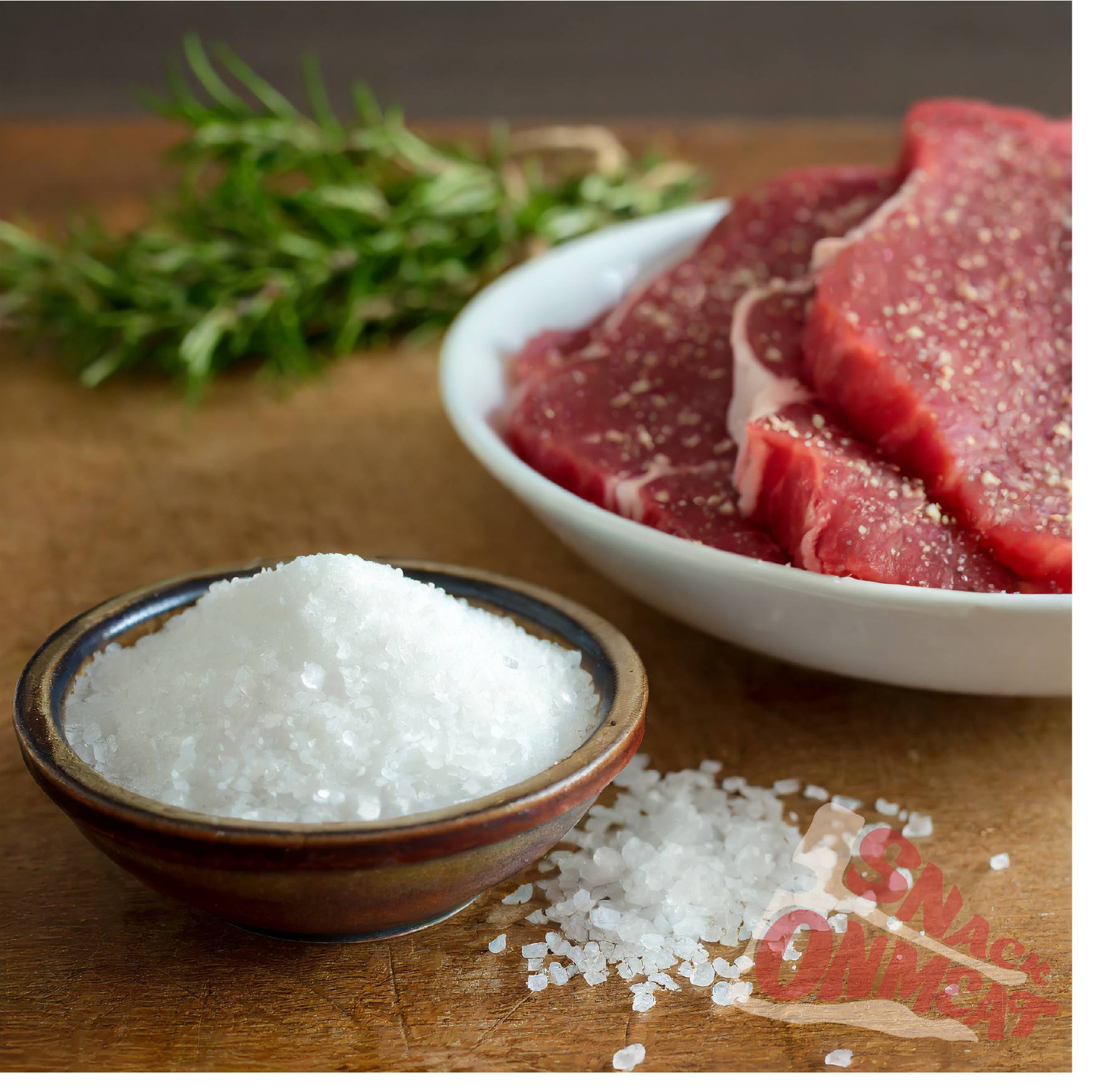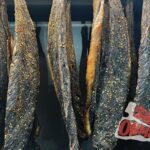In the realm of crafting the perfect jerky, the use of curing salt often sparks debate among enthusiasts. The question of whether curing salt is necessary for making jerky boils down to two essential factors: flavour and safety.
While it’s entirely possible to make jerky without curing salt, its inclusion brings significant benefits. Curing salt not only enhances the flavour profile of the jerky but also plays a critical role in ensuring its safety by preventing the growth of harmful bacteria.
For those who prioritise the traditional jerky taste and want to extend the shelf life of their product, curing salt is a valuable ingredient. However, for individuals seeking alternatives or those with health concerns related to synthetic nitrites, there are viable options available, such as natural sources like celery juice powder or beet powder.
In essence, the necessity of curing salt for making jerky depends on your preferences and priorities. If you’re after the classic jerky flavour with a focus on safety and longevity, curing salt is a valuable ally. For those exploring alternative methods, the key is to strike a balance that aligns with your taste preferences and safety considerations.
we’ll explore the ins and outs of jerky production, covering topics from the necessity of curing salt to potential alternatives and the consequences of its overuse.

Can You Make Jerky Without Curing Salt?
The age-old tradition of making jerky involves marinating meat, and then slowly dehydrating it to create a chewy, flavorful snack. One of the key ingredients traditionally used in this process is curing salt, a mixture of regular salt and sodium nitrite or sodium nitrate. Curing salt enhances flavour but also plays a crucial role in preventing the growth of harmful bacteria.
However, you can make jerky without curing salt, and many home chefs opt for this method, often for reasons ranging from personal preference to health considerations. The absence of curing salt, however, requires careful attention to other aspects of the jerky-making process to ensure both flavor and safety.
To make jerky without curing salt, consider the following steps:
- Lean Meat Selection: Choose lean cuts of meat to reduce fat content, as fat can lead to quicker spoilage. Beef, venison, or turkey are popular choices.
- Proper Marination: Instead of relying on curing salt, focus on a robust marinade to impart flavor and aid in preservation. A typical marinade might include soy sauce, Worcestershire sauce, vinegar, salt, pepper, and various spices.
- Acidic Elements: Incorporate acidic components like vinegar or citrus juices into your marinade. The acidity helps inhibit bacterial growth and adds a tangy depth to the jerky.
- Sugar for Balance: Add a sweet element like brown sugar or honey to balance the savory flavors and contribute to the preservation process.
- Thorough Dehydration: Ensure the jerky is thoroughly dehydrated during the drying process. Removing moisture is crucial for preventing bacterial growth and extending the shelf life of your jerky.
- Optimal Storage: Store your homemade jerky in airtight containers or vacuum-sealed bags. Keep it in a cool, dry place to maintain freshness.
It’s important to note that jerky made without curing salt has a shorter shelf life compared to its cured counterpart. While the flavor can be equally delightful, the absence of curing salt makes the jerky more susceptible to spoilage, requiring consumption within a shorter timeframe.

What Can You Use Instead of Curing Salt?
If you’re opting for a jerky recipe without curing salt, there are alternative methods to help preserve the meat and achieve that classic jerky taste. One popular substitute is using ingredients with natural preserving properties:
- Salt: While not a direct replacement, using a higher concentration of regular salt can help slow bacterial growth. This method, however, may not be as effective as curing salt in preventing certain bacteria and achieving the desired shelf life.
- Vinegar: Adding vinegar to your marinade can contribute both flavour and antimicrobial properties, helping to inhibit bacterial growth. It’s essential to strike the right balance, as too much vinegar can alter the taste of your jerky.
- Citrus Juices: The acidity in citrus juices, such as lemon or lime, can act as a natural preservative. Incorporating these juices into your marinade can enhance the flavour profile while providing a degree of protection against spoilage.
- Sugar: Sugars, such as brown sugar or honey, not only add sweetness to your jerky but also assist in preserving the meat. Be cautious with the amount used, as excessive sugar can lead to a sticky texture.
How Long Will Jerky Last Without Using Curing Salt?
The shelf life of jerky made without curing salt is notably shorter compared to its cured counterpart. While properly cured jerky can last for months, uncured jerky is best consumed within a shorter timeframe.
Without curing salt, the primary factors influencing jerky’s shelf life include:
- Storage Conditions: Storing your jerky in a cool, dry place can help extend its life. Consider vacuum-sealing or using airtight containers to minimize exposure to air and moisture.
- Meat Type: Different types of meat have varying levels of fat content, affecting how long the jerky will keep. Lean meats generally last longer than fattier cuts.
- Preparation Methods: Thoroughly drying the jerky during the dehydration process is crucial for reducing moisture content, a key factor in preventing bacterial growth.
- Additional Preservatives: If you’ve opted for alternative preservatives like salt, vinegar, or citrus juices, their effectiveness will influence the jerky’s longevity.
It’s recommended to consume uncured jerky within a few days to a couple of weeks to ensure optimal quality and safety.
What Happens if You Use Too Much Curing Salt?
While curing salt is a crucial ingredient in jerky-making, using too much can have adverse effects on both flavor and health. Curing salt is potent, and exceeding recommended quantities can lead to an overly salty taste, making the jerky unpalatable.
Moreover, excessive consumption of nitrites, present in curing salt, has been linked to health concerns. Nitrites can form nitrosamines, compounds that may have carcinogenic properties. It’s crucial to follow jerky recipes precisely, balancing flavor and safety.
Alternatives to Curing Salt
For those seeking a middle ground between traditional curing salt and going entirely without, there are alternative curing salts available. These substitutes often use natural sources of nitrites, such as celery juice or beet powder, providing a safer option for those concerned about the potential health risks associated with synthetic nitrites.
- Celery Juice Powder: Naturally high in nitrates, celery juice powder has gained popularity as a nitrite source in curing blends. While it offers a more natural alternative, it’s essential to note that nitrate levels can vary.
- Beet Powder: Similar to celery juice powder, beet powder contains nitrates. Its vibrant colour adds a visual appeal to your jerky, and it serves as a viable option for those aiming to reduce reliance on synthetic curing salts.
- Sea Salt: Opting for sea salt as a base for your curing mix can add depth to the flavour while providing a more natural alternative to regular table salt.
Conclusion
In the grand debate over whether curing salt is necessary for making jerky, the answer lies in striking a balance between flavour, safety, and personal preference. While curing salt undeniably plays a vital role in preserving jerky and preventing bacterial growth, there are alternatives for those looking to experiment or address health concerns.
Whether you choose to stick to tradition with curing salt, explore natural substitutes, or craft jerky without any curing agents, the key is understanding the implications of your choices. Experimenting with different methods, flavors, and curing agents can lead to the discovery of your perfect jerky recipe, satisfying both your taste buds and your desire for a safe and enjoyable snacking experience.
Recent Posts:
- The Truth About Beef Jerky And Your Health
 A favourite among outdoor enthusiasts for its transportability, for fitness enthusiasts for …
A favourite among outdoor enthusiasts for its transportability, for fitness enthusiasts for … - Kangaroo Biltong: How To Make It
 We all know beef, game, and ostrich are the most traditional meats …
We all know beef, game, and ostrich are the most traditional meats … - What Is Biltong? Everything You Need To Know
 In the world of savoury snacks, one delicacy stands out for its …
In the world of savoury snacks, one delicacy stands out for its …





